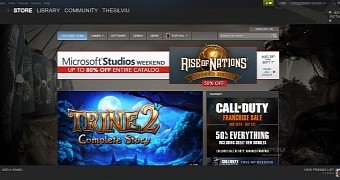Valve released a new Beta version of the Steam distribution platform and the developers have implemented quite a few changes, including a very interesting one related to the In-Home streaming feature.
Valve usually goes through quite a few Beta versions before deciding to release a new stable client update and now the developers have released a very consistent update. It bring numerous features and various modifications, but it also comes with a big improvements for the Linux platform.
The In-Home Streaming option is Valve's temporary solution to the lack of Linux support for most of the new games. With this option on, it's possible to play Windows games on SteamOS by streaming them from one computer to another.
It might seem like a cumbersome solution and it actually is, for the most part. Until all the developers release games for all the supported platforms, Linux users will be forced to use this solution to play Windows-based games. In fact, this solution implemented by Valve is faster than Wine, but it's also more expensive because it requires to have another PC.
According to the changelog, a regression that prevented public sharing of screenshots of non-Steam games has been fixed, it's now possible to install from retail disk for games with more than 4 DVDs and to use the data from all disks, game banners are now appearing in the offline mode in grid view, the Family View recovery email address can now be specified in the Big Picture Family View setup, a warning sound is now playing when unlocking the Family View in desktop mode, and some permissions issues that were preventing developers from uploading Workshop items to an app using the ISteamUGC interface have been fixed.
Also, a rare crash that occurred on startup has been fixed, the energy usage when running in the background has been reduced, support has been added for NVIDIA ShadowPlay, which enables hardware accelerated OpenGL capture, support has been added for AMD VCE hardware encoding of D3D games, support for streaming from Linux hosts has been implemented, and the application will now scan for music inside the Steam directories.
You can find a more detailed list of changes in the official announcement.
If you don’t have the client, you can download the Steam for Linux installer from Softpedia. This is not the actual application, but a small tool provided by Valve that downloads the software and takes care of any dependencies.

 14 DAY TRIAL //
14 DAY TRIAL //